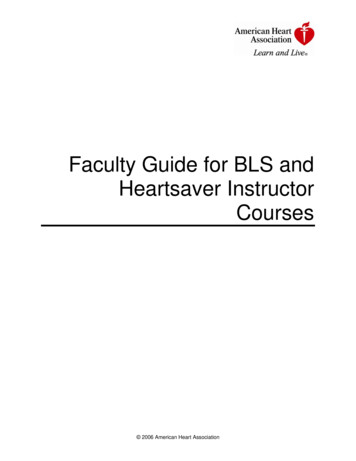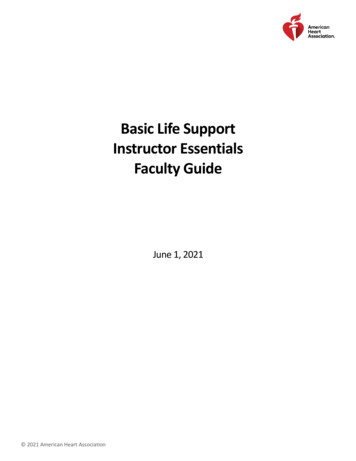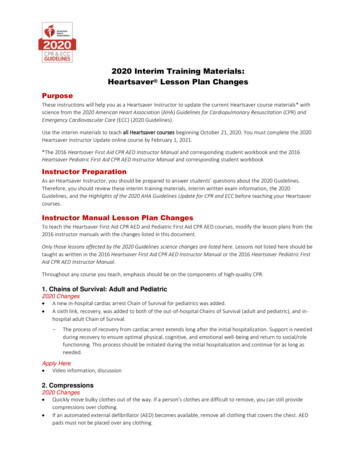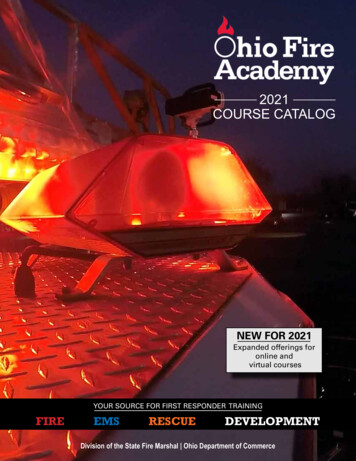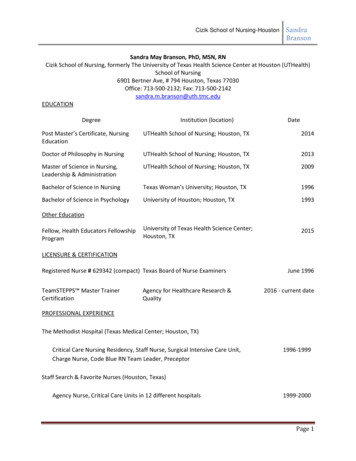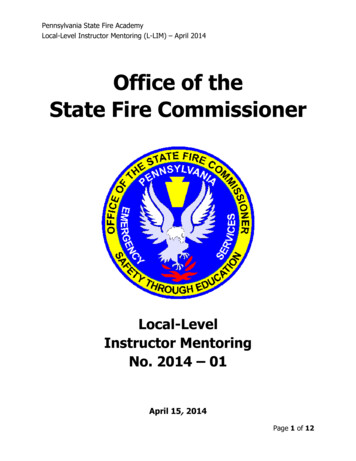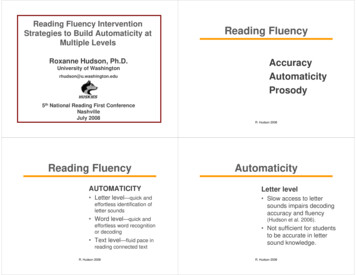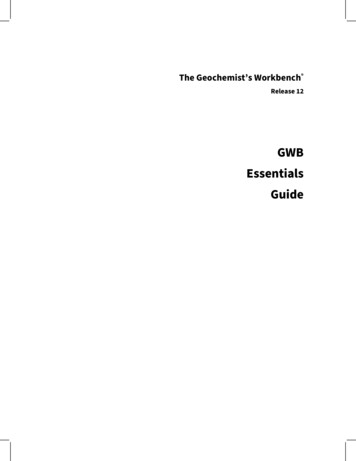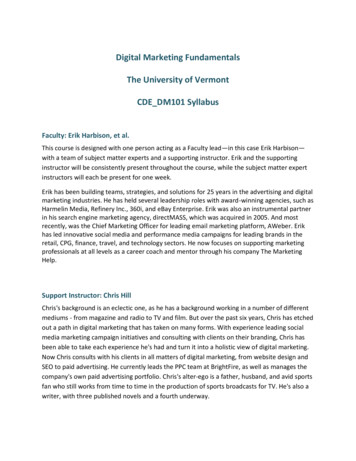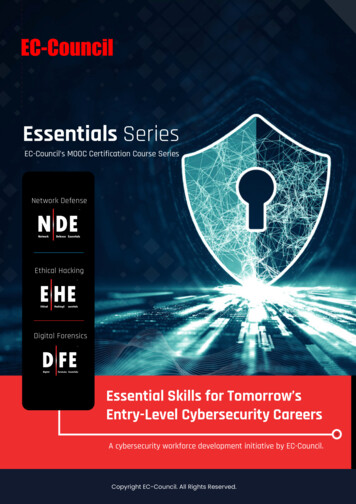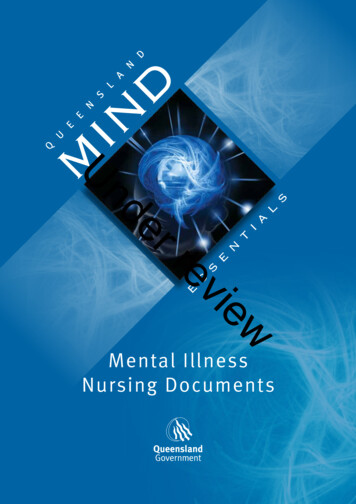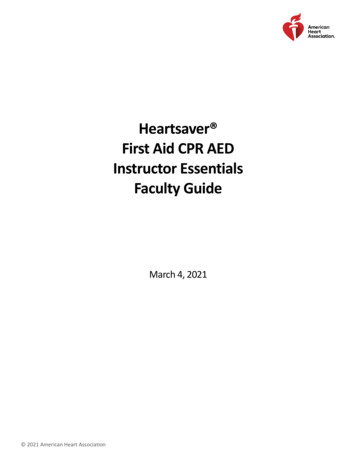
Transcription
Heartsaver First Aid CPR AEDInstructor EssentialsFaculty GuideMarch 4, 2021 2021 American Heart Association
ContentsPart 1: General Concepts .1About This Faculty Guide . 1Educational Design . 1Steps to Become an Instructor . 1Role of Faculty . 1Find or List a Course . 2Faculty–to–Instructor Candidate Ratio . 2Room Requirements and Course Materials . 2Sample Precourse Letter to Instructor Candidates . 3Using Lesson Plans . 3Understanding Icons . 4Part 2: Preparing for the Course .5Who Can Take the Course . 5Course Materials and Equipment. 5Part 3: Teaching the Course .7Course Outline and Sample Agenda. 7Part 4: Heartsaver Instructor Essentials Course Faculty Lesson Plans .10To find out about any updates or corrections to this text, visit heart.org/courseupdates.Heartsaver Instructor Essentials Faculty Guide 2021 American Heart Association
Part 1: General ConceptsAbout This Faculty GuideWelcome to the American Heart Association (AHA) Instructor Essentials Course. This course will prepare instructorcandidates to teach AHA instructor-led and blended-learning course formats. This Instructor Essentials course educatesparticipants on how to adequately use instructor teaching materials, ensure that students meet learning objectives,offer student coaching skills, provide an objective skills performance evaluation, and follow AHA Instructor and coursepolicies. The course covers core content and discipline-specific content required to teach AHA courses.We have organized our faculty guides to provide this introductory section, which discusses the basic logistics forconducting any AHA Instructor Essentials course. The remaining Parts of this guide cover course-specific information.Educational DesignThe Instructor Essentials Course is taught in a blended-learning format. To become an AHA Instructor, candidates mustcomplete the online portion, followed by the hands-on session, which is classroom based. The online portion of thecourse contains both core content and discipline-specific modules to prepare the instructor candidates for the hands-onsession. In the classroom, faculty will continue preparing instructor candidates to become AHA Instructors by focusingon in-depth material about the disciplines that candidates will be teaching. The hands-on session includes instruction,practice, and an exam, allowing instructor candidates to successfully use their instructor materials and skills. Review thesteps to become an instructor in the next section.Steps to Become an InstructorThere are 4 steps to become an AHA Instructor. For successful completion, instructor candidates must1. Be accepted by an AHA Training Center (TC) before enrolling in an Instructor Essentials Course and have a completedInstructor Candidate Application on file with that TC2. Have current AHA Provider status in the discipline for that Instructor Essentials Course and be proficient in all theskills of that discipline3. Successfully complete the Instructor Essentials Course, including both the online and hands-on session4. Successfully be monitored teaching within 6 months after completing the hands-on session of the InstructorEssentials Course (Training Center Coordinators [TCCs] may require additional monitoring, if needed)Role of FacultyThis guide, including the lesson plans, is for Training Faculty (TF) who will be teaching the hands-on session of theInstructor Essentials Course. The purpose of this faculty guide and the lesson plans is to provide faculty with materialsthat contain new information and educational practices that are incorporated into the 2020 product development cycle.These materials are to be used as a guide for teaching and preparing instructor candidates to become AHA Instructors.We thank you for your continuous efforts in conducting the hands-on session of Instructor Essentials.As faculty, your role is critical to successful instructor candidate outcomes. During the course, the faculty should Facilitate discussions with a focus on desired outcomeListen to instructor candidates’ responses and provide feedback to ensure understanding of learning conceptsObserve instructor candidates’ actions and coach as neededGive positive and corrective feedbackKeep discussions and activities on track for optimal learning and use of time in the classroomHeartsaver Instructor Essentials Faculty Guide 2021 American Heart Association1
Find or List a CourseUse the AHA’s Find a Course link on the Instructor Network to list your courses. Instructor candidates will then be ableto access this information through the AHA’s online Course Catalog (cpr.heart.org/en/course-catalog-search) or byphone at 1-877-AHA-4CPR (1-877-242-4277). This tool is for US TCs only.TC profile information is entered in the Instructor Network by the TCC. The AHA encourages TCs to post scheduledcourses on the Instructor Network. With permission from the TCC, TC Faculty may also post scheduled courses. The Finda Course online tool is not available to international Training Centers and Instructors.Many TCs also have websites where they post information about AHA courses.AHA Instructor Instructor Candidate RatioKeep track of how many people are enrolled in the course. Determine how many faculty members are needed to teachand who will be Lead Faculty. The size for each Instructor Essentials Course is flexible, but it is ideal that 1 facultymember conduct an Instructor Essentials Course with up to 7 instructor candidates, so as not to exceed a 1:7 ratio. Thisratio is ideal because throughout the course, there are group activities where 1 instructor candidate would play the roleof instructor and the other candidates would play the role of students. Two manikin stations would be needed for aninstructor course of 7 candidates.Room Requirements and Course MaterialsWhen selecting a location for the Instructor Essentials Course, make sure the room has Good acousticsA clean and well-maintained environmentBright lighting that can be adjusted for video presentationsAn instructor-controlled video player and a monitor or screen large enough to be viewed by all instructor candidatesA chair for each instructor candidateIdeally, a firm surface with adequate padding or protection for skills practice (eg, carpeted floors, sturdy table top,padded mats)A table for completing the examOnce the course has been scheduled, contact your TCC for all equipment needed for this course. Make sure you haveany additional support materials needed, such as posters, pocket reference cards, or emergency crash cart cards.If you need to order manikins or support materials, check with your TCC or contact an AHA distributor. The distributorsare listed on the Instructor Network. The TCC is responsible for ordering all course completion cards.You can find a detailed materials and equipment list for your course in Part 2 of this faculty guide.Heartsaver Instructor Essentials Faculty Guide 2021 American Heart Association2
Sample Precourse Letter to Instructor CandidatesThe letter below is a sample you may modify and send to instructor candidates attending the hands-on session of theInstructor Essentials Course.(Date)Dear Instructor Candidate:Welcome to the hands-on session of the Instructor Essentials Course. Enclosed are the agenda and your copy ofthe instructor manual(s) and Instructor Essentials Instructor Candidate Workbook. You will also need to access theInstructor Essentials online course (available at elearning.heart.org) to complete before coming to class. Please bringyour instructor manual(s) and Instructor Essentials online course completion certificate to the course. Reviewboth the agenda and the instructor manual(s) before coming to class so that you learn more and are more comfortablewith the course.The class is scheduled forDate:Time:Location:Please wear loose, comfortable clothing. You will be practicing skills that require working on your hands and knees,bending, standing, and lifting. If you have physical conditions that might prevent you from participating in the course,please tell one of the faculty when you arrive for the course. Faculty will work to accommodate your needs within thestated course completion requirements. In the event that you are ill, please notify your faculty to reschedule yourtraining.We look forward to welcoming you on (day and date of class). If you have any questions about the course, please call(name) at (telephone number).Sincerely,(Name), FacultyUsing Lesson PlansUse lesson plans before and during the course.Before the courseReview the lesson plans to understand Objectives for each lessonYour role for each lessonResources that you need for each lessonMake notes of things you want to remember or add, and consider preparing a list of questions and answers to useduring a debrief of the lessons.During the course Follow each lesson plan as you conduct the course.Make sure you have all the resources, equipment, and supplies ready for each lesson.Help the instructor candidates achieve the objectives identified for each lesson.Heartsaver Instructor Essentials Faculty Guide 2021 American Heart Association3
Understanding IconsThe icons used in the lesson plans are there to remind you to take certain actions during the course. The icons usedthroughout the lesson plans are listed in Table 1.Table 1. Lesson Plan IconsIconActionDiscussionPlay videoInstructor candidate practiceInstructor candidate materialsExamHeartsaver Instructor Essentials Faculty Guide 2021 American Heart Association4
Part 2: Preparing for the CourseWho Can Take the CourseThe Heartsaver Instructor Essentials Course is an intensive course for instructor candidates who have alreadysuccessfully completed the Heartsaver First Aid CPR AED Course. The role and scope of practice of lay rescuers can varygreatly, so there are no profession-specific guidelines for becoming an AHA Instructor in a specific discipline.Instructor candidates should exemplify integrity, demonstrate strong ethics, communicate clearly, and model adedication to quality of training.Heartsaver instructor candidates must meet certain requirements before taking the Instructor Essentials Course. Beforeattending the hands-on session (facilitated by faculty), all instructor candidates must Be at least 18 years of ageBe aligned with an AHA TC Instructor candidates must have a TC that has agreed to accept them as an instructor once they have completedInstructor Essentials and their monitoring is completed.Have a current AHA Heartsaver First Aid CPR AED course completion cardBe proficient in the skills of Heartsaver First Aid CPR AED To measure the proficiency of the skills of Heartsaver First Aid CPR AED, be sure to observe instructor candidatesduring the course. If you feel that instructor candidates need to be retested in their first aid or CPR and AEDskills, you can include this as part of the Instructor Essentials Course.Complete an Instructor Candidate ApplicationSuccessfully complete the online portion of Instructor EssentialsIf you have any questions about prerequisites, please consult your TCC.Course Materials and EquipmentEquipment required for each class held is listed in Table 2. All equipment used must be in proper working order andgood repair.Table 2. Classroom Equipment and SuppliesQuantity1 per faculty1 per instructorcandidateMaterials and equipment Heartsaver Instructor Essentials Faculty Guide with lesson plansProgram Administration ManualHeartsaver student course materials: Heartsaver First Aid CPR AED Instructor Manual, lesson plans,and course video (or course DVD)BLS and Heartsaver Instructor Essentials Course videos (or course DVD) 1-way valve and pocket maskCourse agendaHeartsaver Adult CPR and AED Skills Testing ChecklistHeartsaver Child CPR Skills Testing Checklist (at least 2 copies)Heartsaver Infant CPR Skills Testing Checklist (at least 2 copies)Heartsaver First Aid Skills Testing Checklist (at least 2 copies)Heartsaver Instructor Essentials ExamInstructor Essentials Instructor Candidate WorkbookHeartsaver First Aid CPR AED or Pediatric First Aid CPR AED Instructor Manual Heartsaver Instructor Essentials Faculty Guide 2021 American Heart Association5
QuantityMaterials and equipment Heartsaver First Aid CPR AED or Pediatric First Aid CPR AED Student Workbook*Heartsaver First Aid CPR AED or Pediatric First Aid CPR AED course exam*Pair of latex-free gloves (optional)1 per set of 3instructor candidates(3:1 ratio) AED trainer with adult padsManikins with shirts for adult, child (optional), and infantPocket mask (if not enough for 1 per instructor candidate)StopwatchEpinephrine pen trainer (optional)Small stack of gauze pads (4 4 inches) (optional)1 bandage (roll of gauze) (optional)Magazines for splint (optional)1 per course TV with DVD player or computer with video player and projection screenCourse rosterManikin cleaning supplies*Instructor candidates can use either the Heartsaver First Aid CPR AED course materials or the Pediatric First Aid CPRAED course materials for the Heartsaver Instructor Essentials Course, depending on the course they will be teaching.Heartsaver Instructor Essentials Faculty Guide 2021 American Heart Association6
Part 3: Teaching the CourseCourse Outline and Sample AgendaHeartsaver Instructor Essentials Course OutlineApproximate course duration without breaks: 4.5 hoursInstructor candidate–faculty ratio 7:1; instructor candidate–manikin ratio 3:1Lesson times below are estimates and can vary from course to course.Lesson1Course eventLesson plan actions and timeestimate (in minutes)Course Introduction5234567AHA IntroductionPart 1: AHA MissionPart 2: Instructor Core CompetenciesAHA Instructor ResourcesPart 1: Program Administration ManualPart 2: Other Electronic ResourcesPart 3: Training Center–Specific PoliciesHeartsaver Course PreparationPart 1: Course PaperworkPart 2: Course PreparationHeartsaver Course Overview (Instructor-Led)Part 1: Course FormatsPart 2: Instructor MaterialsPart 3: Learning Objectives and CourseCompletion RequirementsFirst AidPart 1: First Aid OverviewPart 2: Lesson 2: First Aid Basics: Duties and Key StepsPart 3: Lesson 3: First Aid Basics SummaryPart 4: Lessons 4: Medical Emergencies/ Medical EmergenciesSummaryPart 5: Lessons 6-7: Injury Emergencies/Injury EmergenciesSummaryPart 6: Lessons 8-12: Environmental Emergencies, EnvironmentalEmergencies Summary, Preventing Illness and Injury, LegalQuestions, and Course ConclusionFirst Aid Skills Testing and ExamPart 1: First Aid Skills TestingPart 2: Heartsaver ExamHeartsaver Instructor Essentials Faculty Guide 2021 American Heart Association1520151535157
Lesson89101112Lesson plan actions and timeestimate (in minutes)Course eventAdult CPR AEDPart 1: Lesson 2: Adult CPRPart 2: Lesson 3: Use an AED (Adult)Part 3: Lesson 4: Adult CPR AED ConclusionPart 4: Lesson 6: Drug OverdosePart 5: Lesson 7: Adult Choking30Child CPR AED and Infant CPRPart 1: Child CPR AEDPart 2: Infant CPR30CPR AED Skills TestingPart 1: Heartsaver CPR AED Skills TestingPart 2: Remediation45Heartsaver Blended-Learning CoursesPart 1: Heartsaver Blended Learning OverviewPart 2: Heartsaver Hands-on Session20Course Conclusion and ExamPart 1: Course ConclusionPart 2: Heartsaver Instructor Essentials Exam30Sample Heartsaver Instructor Essentials Course Agenda7 instructor candidates, 1 facultyInstructor candidate–faculty ratio 7:1; instructor candidate–manikin ratio 3 or 4:1Total time: Approximately 5.5 hoursTimeLesson8:00-8:05Lesson 1: Course Introduction8:05-8:20Lesson 2: AHA IntroductionPart 1: AHA MissionPart 2: Instructor Core Competencies8:20-8:40Lesson 3: AHA Instructor ResourcesPart 1: Program Administration ManualPart 2: Other Electronic ResourcesPart 3: Training Center–Specific Policies8:40-8:55Lesson 4: Heartsaver Course PreparationPart 1: Course PaperworkPart 2: Course Preparation8:55-9:10Lesson 5: Heartsaver Course Overview (Instructor-Led)Part 1: Course FormatsHeartsaver Instructor Essentials Faculty Guide 2021 American Heart Association8
TimeLessonPart 2: Instructor MaterialsPart 3: Learning Objectives and Course Completion Requirements9:10-9:45Lesson 6: First AidPart 1: First Aid OverviewPart 2: Lesson 2: First Aid Basics: Duties and Key StepsPart 3: Lesson 3: First Aid Basics SummaryPart 4: Lessons 4-5: Medical EmergenciesPart 5: Lessons 6-7: Injury EmergenciesPart 6: Lessons 8-12: Environmental Emergencies, Preventing Illness and Injury, Legal Questions, andCourse Conclusion9:45-10:00Lesson 7: First Aid Skills Testing ExamPart 1: First Aid Skills TestingPart 2: Heartsaver Exam10:00-10:15Break10:15-10:45Lesson 8: Adult CPR AEDPart 1: Lesson 2: Adult CPRPart 2: Lesson 3: Use an AED (Adult)Part 3: Lesson 4: Adult CPR/AED ConclusionPart 4: Lesson 6: Drug OverdosePart 5: Lesson 7: Adult Choking10:45-11:15Lesson 9: Child CPR AED and Infant CPRPart 1: Child CPR AEDPart 2: Infant CPR11:15-12:00Lesson 10: CPR AED Skills TestingPart 1: CPR AED Skills TestingPart 2: Remediation12:00-12:30Lunch12:30-12:50Lesson 11: Heartsaver Blended-Learning CoursesPart 1: Heartsaver Blended Learning OverviewPart 2: Heartsaver Hands-on Session12:50-1:20Lesson 12: Course Conclusion and ExamPart 1: Course ConclusionPart 2: Heartsaver Instructor Essentials ExamHeartsaver Instructor Essentials Faculty Guide 2021 American Heart Association9
Part 4: Heartsaver Instructor Essentials Course Faculty Lesson PlansPrecourseFaculty TipPrepare for your role as a Heartsaver faculty instructor well. Thoroughly review the Heartsaver First Aid CPR AED Courseinstructor materials. The time you invest in this part of your preparation is important to the overall success of everystudent and will allow the course to run smoothly.30 to 60 Days Before the Course Schedule a room that meets the room requirements for the Instructor Essentials Course.Reserve all needed equipment to teach the course.Schedule additional faculty, if needed, depending on the size of the class.At Least 3 Weeks Before the Course Review the Heartsaver First Aid CPR AED course materials: Heartsaver First Aid CPR AED course video Heartsaver First Aid CPR AED Student Workbook Heartsaver First Aid CPR AED Instructor Manual Heartsaver First Aid CPR AED online portionRead this faculty guide and lesson plans. Prepare any questions for each lesson in advance.Review the Program Administration Manual (PAM).Send participating instructor candidates precourse letters, course materials, and the course agenda. If instructor candidates will be teaching Pediatric First Aid courses, then they may use the Heartsaver PediatricFirst Aid Course materials instead of Heartsaver First Aid CPR AED1 Week Before the CourseConfirm room reservations and ensure that all required equipment needed is available for the course.Day Before the Course Set up the room and make sure that all technology and equipment are working properly. This can also be done onthe day of the course, before class begins, if the room is not accessible the day before.Coordinate the roles and responsibilities with additional faculty, if needed, to fulfill the course agenda and to ensureefficiency and timing of the course.Ensure that all course paperwork is in order.Verify that all instructor candidates have successfully passed the Heartsaver First Aid CPR AED Course by viewingtheir current Heartsaver First Aid CPR AED course completion cards.Day of the CourseArrive at the course location in plenty of time to complete the following: Have the video ready to play before instructor candidates arrive and make sure it is working properly with sound.Distribute supplies to the instructor candidates or set up supplies for instructor candidates to collect when theyarrive, with clear instructions on what they need.Greet instructor candidates as they arrive to put them at ease, and direct them where to go.Make sure the course roster is completed by all instructor candidates as they arrive for the course.Heartsaver Instructor Essentials Faculty Guide Lesson Plans 2021 American Heart Association10
Lesson 1Course Introduction5 minutesFaculty Tips Be familiar with the learning objectives and the Heartsaver Instructor Essentials Course content. It’s critical that youknow what you want to communicate, why it’s important, and what you want to happen as a result.Think about how you want to manage breaks during the course. Making yourself available during breaks allows youto answer questions people might feel too embarrassed to ask in front of everyone. It also gives you time toestablish rapport and get feedback.Discussion Introduce yourself and additional faculty, if present.Invite instructor candidates to introduce themselves.Explain that the course is interactive. Refer to the following points for discussion with instructorcandidates:– Your role– Video-based and hands-on learning with practice Explain to instructor candidates that during the course, they will have the opportunity to gothrough the overall flow of the Heartsaver portfolio, with extensive practice demonstratinginstructor skills.– The use and reference of the instructor manual, lesson plans, and skills testing checklists– ExamAsk that any instructor candidate who anticipates difficulties because of personal limitations, such as amedical concern or knee or back problems, speak with one of the faculty.Explain the layout of the building, including bathrooms and emergency exits.Remind instructor candidates that all AHA courses are to be conducted in a smoke-free facility,including surrounding grounds, parking lots, and entrances.Remind instructor candidates of where the nearest AED is located and what their emergency responsenumber is.Describe the course agenda:– Inform instructor candidates of breaks you have scheduled during the class.– Tell the instructor candidates, “We are scheduled to end at .”Remind instructor candidates what they will learn during the course. At the end of the HeartsaverInstructor Essentials Course, instructor candidates will be able to– Identify the prerequisites to becoming an AHA Instructor– Describe the usability of the Program Administration Manual– Describe the core competencies of an AHA Instructor– Describe the 5 steps of the AHA Instruction Cycle: prepare, teach, test and remediate, close, andkeep current– Identify resources available to an AHA Instructor– Describe how to use discipline-specific AHA Instructor materials: the instructor manual, lessonplans, course videos, and skills testing checklists– Identify discipline-specific course formats available to instructor candidates for completion of thecourse– Describe discipline-specific course completion requirements– Describe discipline-specific flexibility options available to an AHA Instructor within the course– Describe the requirements for how to maintain AHA Instructor status– Describe effective AHA Instructor feedback and remediation techniques– Demonstrate the administration of skills testing with the use of the skills testing checklistsHeartsaver Instructor Essentials Faculty Guide Lesson Plans 2021 American Heart Association11
Remind instructor candidates that they must score at least 84% on the exam as part of the coursecompletion requirements.Encourage instructor candidates to write notes in their instructor candidate workbook and instructormanual throughout the course.Heartsaver Instructor Essentials Faculty Guide Lesson Plans 2021 American Heart Association12
Lesson 2AHA Introduction15 minutesPart 1: AHA MissionPart 2: Instructor Core CompetenciesLearning Objective Describe the core competencies of an AHA InstructorFaculty TipBecome familiar with the AHA Mission, AHA Global Mission, and Emergency Cardiovascular Care (ECC) GuidingPhilosophy and with the instructor core competencies before teaching this lesson.Instructor Candidate MaterialsFor this lesson, instructor candidates need their instructor candidate workbook accessible to follow alongwith the AHA Mission, AHA Global Mission, and ECC Guiding Philosophy.Discussion: AHA MissionDiscuss the following mission statements with instructor candidates by first choosing an instructorcandidate to read each of the mission statements aloud from the instructor candidate workbook and thendiscussing as a group their role in the overall AHA Mission, AHA Global Mission, and ECC GuidingPhilosophy.AHA MissionOur mission is to build healthier lives, free of cardiovascular disease and stroke. That single purpose drivesall we do. The need for our work is beyond question.The AHA is the nation’s oldest and largest voluntary health organization dedicated to saving people fromheart disease and stroke, America’s No. 1 and No. 5 killers, respectively. The AHA is the trusted leader inECC and trains people around the world in how to save lives with CPR and first aid.AHA Global MissionThe AHA is a relentless force for a world of longer, healthier lives. Through collaboration with globalpartners, our network of training centers and knowledge transfer of proven programs and strategies, theAHA strives to reduce the global burden of cardiovascular diseases and stroke. This mission contributes tothe World Health Organization’s global fight against noncommunicable diseases and the achievement ofthe 2030 Sustainable Development Goal of reducing premature mortality from non-communicablediseases by one third through prevention and treatment and promote mental health and well-being.ECC Guiding Philosophy Improve the Chain of Survival in every communityIncrease the quality and timeliness of materialsIdentify and expand trainingDocument effectivenessImprove efficiencyThe goal of the AHA’s ECC Programs is to be the world’s premier resuscitation organization and serve theglobal community of scientists, healthcare providers, and citizens as a critical leader in the discovery,processing, and transfer of resuscitation science. Our programs, products, and services focus onmaximizing survival from life-threatening cardiovascular emergencies.Heartsaver Instructor Essentials Faculty Guide Lesson Plans 2021 American Heart Association13
Discussion: Instructor Core CompetenciesReview the following instructor core competencies with instructor candidates, providing an example ofhow each competency can be demonstrated in the classroom. Remind instructor candidates that thesecompetencies were discussed in the Instructor Essentials online course and can be found in the instructorcandidate workbook. Skills: Instructors need to be proficient in all the skills of the disciplines that they teach.Course delivery: Instructors need to teach AHA materials correctly and as they were intended.Testing: Instructors need to be able to test their students effectively.Professionalism: Instructors need to maintain a high standard of ethics and professionalism whenteaching AHA courses.Program administration: Instructors need to be able to manage time, space, materials, and paperworkin compliance with AHA guidelines.Heartsaver Instructor Essentials Faculty Guide Lesson Plans 2021 American Heart Association14
Lesson 3AHA Instructor Resources20 minutesPart 1: Program Administration ManualPart 2: Other Electronic ResourcesPart 3: Training Center–Specific PoliciesLearning Objectives Describe the usability of the Program Administration Manual Identify resources available to an AHA InstructorFaculty Tips This lesson requires knowledge of the PAM. To access the PAM, visit the Instructor Network and make sure you arefamiliar with the content in the PAM before teaching this lesson.Become familiar with the Instructor Network and your TC-specific policies to lead a discussio
Mar 04, 2021 · First Aid CPR AED . Instructor Essentials . Faculty Guide . March 4, 2021 . . Heartsaver First Aid CPR AED Instructor Manual, lesson plans, and course video (or course DVD) . Pair of latex-free gloves (o
